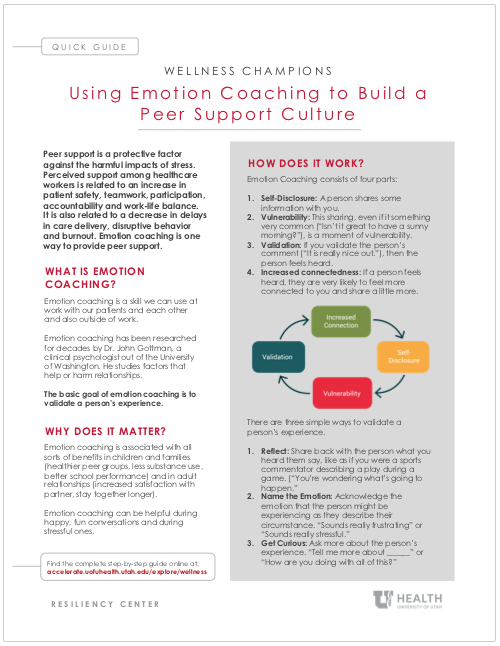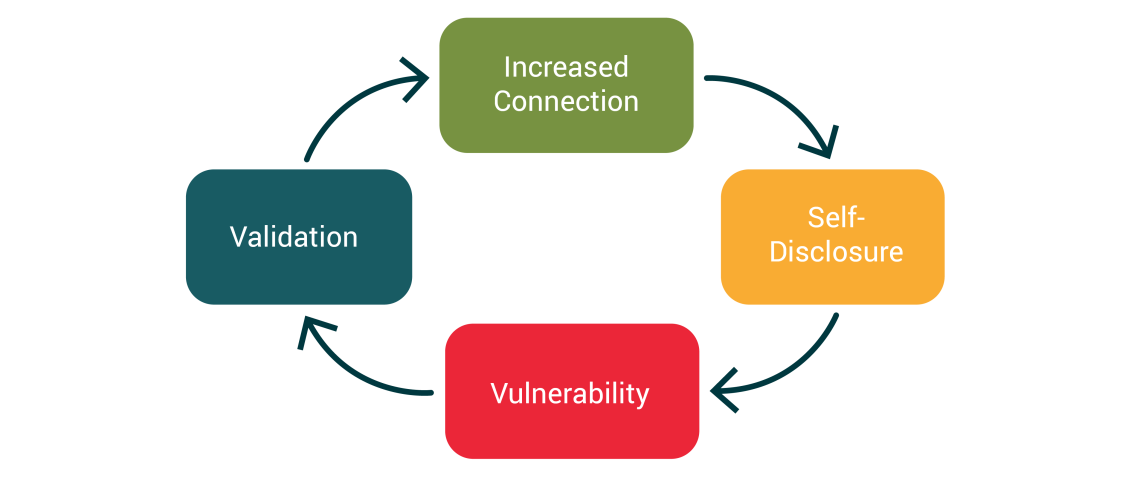
Download the 2-page Quick Guide here.
eer support is a protective factor against the harmful impacts of stress. Perceived support among healthcare workers is related to an increase in patient safety, teamwork, participation, accountability and work-life balance. It is also related to a decrease in delays in care delivery, disruptive behavior and burnout. Emotion coaching is one way to provide peer support.
What is Emotion Coaching?
Emotion coaching is a skill we can use at work with our patients and each other and also outside of work.
Emotion coaching has been researched for decades by Dr. John Gottman, a clinical psychologist out of the University of Washington. He studies factors that help or harm relationships.
The basic goal of emotion coaching is to validate a person’s experience.
Why does it matter?
Emotion coaching is associated with all sorts of benefits in children and families (healthier peer groups, less substance use, better school performance) and in adult relationships (increased satisfaction with partner, stay together longer).
Emotion coaching can be helpful during happy, fun conversations and during stressful ones.
How does it work?
Emotion Coaching consists of four parts:
- Self-Disclosure: A person shares some information with you.
- Vulnerability: This sharing, even if it something very common (“Isn’t it great to have a sunny morning?”), is a moment of vulnerability.
- Validation: If you validate the person’s comment (“It is really nice out.”), then the person feels heard.
- Increased connectedness: If a person feels heard, they are very likely to feel more connected to you and share a little more.

There are three simple ways to validate a person’s experience.
- Reflect: Share back with the person what you heard them say, like as if you were a sports commentator describing a play during a game. (“You’re wondering what’s going to happen.”
- Name the Emotion: Acknowledge the emotion that the person might be experiencing as they describe their circumstance. “Sounds really frustrating” or “Sounds really stressful.”
- Get Curious: Ask more about the person’s experience. “Tell me more about ______” or “How are you doing with all of this?”
Give it a try now
Take a look at these example statements under the “Say This” column and see if you can label the statement as a Reflection, Naming the Emotion or Getting Curious.
| Say This | Not This |
|---|---|
|
|
Now, let’s take a moment to practice with a scenario. Read the following statements and say in your mind how you’d emotion coach. Then, choose which of the following two options sounds more like emotion coaching.
Co-Worker: “That’s me, depressed.”
How would you respond?
- “What? Not you, we need you!”
- “Yeah, a lot of people are feeling that way right now.”
Co-Worker: “I just feel tired all the time and I get overwhelmed so easily.”
How would you respond?
- “You should probably get more sleep.”
- “It makes sense. You’re doing a lot.”
Co-Worker: “I know. I just wish I knew when it was going to get better.”
How would you respond?
- “Yeah, you can’t think about that.”
- “Oh man, I hear you. Anything that you’ve done lately that’s been helpful?”
Reflect on your answers. What was it about the responses you chose that indicated emotional coaching for you? Consider how it would feel to emotion coach? What would it feel like for someone to use emotion coaching with you? What is one thing you will take away from this exercise?
Suggestions for implementing in clinic
- Give it a try. Have clinic employees experiment with emotion coaching—either with patients, co-worker or outside of work—and then share their experience with the technique during another group meeting.
- Recognize each other. Have clinic employees recognize each other when they notice a co-worker using emotion coaching. (“I really like the way you used emotion coaching with that last patient.”)
- Incorporate this skill with other exercises from the Wellness Champions toolkit, like check-in questions and the positive psychology tools.
- Get creative! There are many ways to build emotion coaching into team culture.
Three expert tips for clinics
Tip 1: Encourage clinic employees to practice this skill at their own pace. Perhaps they could pick a patient or person to use emotion coaching with and simply try out the skill one or two times in the conversation.
Tip 2: Inform clinic employees that they do not have to name the emotion or experience exactly. The person they are using emotion coaching with will likely correct them if what they say doesn’t quite fit, which is completely normal and helpful.
- Person 1: “It sounds like you’re really frustrated.”
- Person 2: “Actually I’m really worried.”
Tip 3: It’s going to feel weird. We aren’t taught to communicate with each other this way. Typically, when someone brings us a problem, we try to fix it instead of just simply listen. It will take some time and practice for emotion coaching to feel comfortable. Your conversations might move a little more slowly while you’re figuring out how to use the technique.
References:
- Fainsilber Katz, L., Maliken, A., & Stettler, N. (2012). Parental meta-emotion philosophy: A review of research and theoretical framework. Child Development Perspectives, 6(4), 417-422.
- Gottman, J. M., Katz, L. F., & Hooven, C. (1996). Parental meta-emotion philosophy and the emotional life of families: Theoretical models and preliminary data. Journal of Family Psychology, 10(3), 243–268.
- Sexton, B. (2020). Psychological safety: The predictive power of feeling supported when things go wrong [Webinar]. Duke Center for Healthcare Safety and Quality.
Originally published October 2020
Megan Call
Trinh Mai
Megan Jean Whitlock
Wellness Champions use prompts to check-in during meetings, team huddles, hand-offs, etc. Learn this simple way to help your team reconnect to purpose, be more engaged, focused, and cohesive.
We’re all managing unprecedented stress and fear. What is “normal” right now? How do I cope? Social worker Jean Whitlock describes how our body protects us and offers some strategies to help.
We have personal protective equipment (PPE) for our body–but what about our mind? Huntsman Cancer Institute nurse manager Cassidy Kotobalavu has lead training on the concept of emotional contagion–how good (and bad) emotions spread. Here are Cassidy’s expert tips (with slides) on managing emotional contagion in health care.
